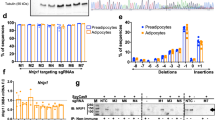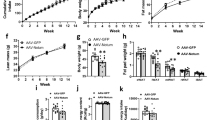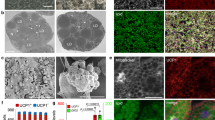Abstract
Obesity is an increasingly prevalent human condition in developed societies. Despite major progress in the understanding of the molecular mechanisms leading to obesity, no safe and effective treatment has yet been found. Here, we report an antiobesity therapy based on targeted induction of apoptosis in the vasculature of adipose tissue. We used in vivo phage display to isolate a peptide motif (sequence CKGGRAKDC) that homes to white fat vasculature. We show that the CKGGRAKDC peptide associates with prohibitin, a multifunctional membrane protein, and establish prohibitin as a vascular marker of adipose tissue. Targeting a proapoptotic peptide to prohibitin in the adipose vasculature caused ablation of white fat. Resorption of established white adipose tissue and normalization of metabolism resulted in rapid obesity reversal without detectable adverse effects. Because prohibitin is also expressed in blood vessels of human white fat, this work may lead to the development of targeted drugs for treatment of obese patients.
This is a preview of subscription content, access via your institution
Access options
Subscribe to this journal
Receive 12 print issues and online access
$209.00 per year
only $17.42 per issue
Buy this article
- Purchase on Springer Link
- Instant access to full article PDF
Prices may be subject to local taxes which are calculated during checkout






Similar content being viewed by others
References
Kopelman, P.G. Obesity as a medical problem. Nature 404, 635–643 (2000).
Leibel, R.L., Edens, N.K. & Fried, S.K. Physiologic basis for the control of body fat distribution in humans. Annu. Rev. Nutr. 9, 417–443 (1989).
Flegal, K.M., Carroll, M.D., Ogden, C.L. & Johnson, C.L. Prevalence and trends in obesity among US adults, 1999-2000. JAMA 288, 1723–1727 (2002).
Fontaine, K.R., Redden, D.T., Wang, C., Westfall, A.O. & Allison, D.B. Years of life lost due to obesity. JAMA 289, 187–193 (2003).
Masuzaki, H. et al. A transgenic model of visceral obesity and the metabolic syndrome. Science 294, 2166–2170 (2001).
Spiegelman, B.M. & Flier, J.S. Obesity and the regulation of energy balance. Cell 104, 531–543 (2001).
Clapham, J.C., Arch, J.R. & Tadayyon, M. Anti-obesity drugs: a critical review of current therapies and future opportunities. Pharmacol. Ther. 89, 81–121 (2001).
Woods, S.C. & Seeley, R.J. Adiposity signals and the control of energy homeostasis. Nutrition 16, 894–902 (2000).
Leibowitz, S.F. Brain peptides and obesity: pharmacologic treatment. Obes. Res. 3 (suppl. 4), 573–589 (1995).
O'Reilly, M.S. et al. Angiostatin: a novel angiogenesis inhibitor that mediates the suppression of metastases by a Lewis lung carcinoma. Cell 79, 315–328 (1994).
Folkman, J. Angiogenesis in cancer, vascular, rheumatoid and other disease. Nat. Med. 1, 27–31 (1995).
Folkman, J. Addressing tumor blood vessels. Nat. Biotechnol. 15, 510 (1997).
Carmeliet, P. Mechanisms of angiogenesis and arteriogenesis. Nat. Med. 6, 389–395 (2000).
Eliceiri, B.P. & Cheresh, D.A. Adhesion events in angiogenesis. Curr. Opin. Cell Biol. 13, 563–568 (2001).
Burrows, F.J. & Thorpe, P.E. Vascular targeting—a new approach to the therapy of solid tumors. Pharmacol. Ther. 64, 155–174 (1994).
Zetter, B.R. Angiogenesis and tumor metastasis. Annu. Rev. Med. 49, 407–424 (1998).
Wasserman, F. The development of adipose tissue. in Handbook of Physiology Vol. 5 (eds. Renold, A. & Cahill, G.) 87–100 (American Physiological Society, Washington, D.C., 1965).
Cinti, S. Anatomy of the adipose organ. Eat. Weight Disord. 5, 132–142 (2000).
Sumi, T., Ishiko, O., Yoshida, H., Hyun, Y. & Ogita, S. Involvement of angiogenesis in weight-loss in tumor-bearing and diet-restricted animals. Int. J. Mol. Med. 8, 533–536 (2001).
Crandall, D.L., Hausman, G.J. & Kral, J.G. A review of the microcirculation of adipose tissue: anatomic, metabolic, and angiogenic perspectives. Microcirculation 4, 211–232 (1997).
Rupnick, M.A. et al. Adipose tissue mass can be regulated through the vasculature. Proc. Natl. Acad. Sci. USA 99, 10730–10735 (2002).
Greene, A.K. et al. Endothelial-directed hepatic regeneration after partial hepatectomy. Ann. Surg. 237, 530–535 (2003).
Kolonin, M.G., Pasqualini, R. & Arap, W. Molecular addresses in blood vessels as targets for therapy. Curr. Opin. Chem. Biol. 5, 308–313 (2001).
Pasqualini, R., Arap, W., Rajotte, D. & Ruoslahti, E. In vivo selection of phage-display libraries. in Phage Display: A Laboratory Manual (eds. Barbas, C., Burton, D., Silverman, G. & Scott, J.) 22.1–22.24 (Cold Spring Harbor Laboratory Press, New York, NY, 2000).
Kolonin, M.G., Pasqualini, R. & Arap, W. Teratogenicity induced by targeting a placental immunoglobulin transporter. Proc. Natl. Acad. Sci. USA 99, 13055–13060 (2002).
Pasqualini, R. & Ruoslahti, E. Organ targeting in vivo using phage display peptide libraries. Nature 380, 364–366 (1996).
Arap, W. et al. Steps toward mapping the human vasculature by phage display. Nat. Med. 8, 121–127 (2002).
Zhang, Y. et al. Positional cloning of the mouse obese gene and its human homologue. Nature 372, 425–432 (1994).
Licinio, J. et al. Phenotypic effects of leptin replacement on morbid obesity, diabetes mellitus, hypogonadism, and behavior in leptin-deficient adults. Proc. Natl. Acad. Sci. USA 101, 4531–4536 (2004).
Ellerby, H.M. et al. Anti-cancer activity of targeted pro-apoptotic peptides. Nat. Med. 5, 1032–1038 (1999).
McClung, J.K., Jupe, E.R., Liu, X.T. & Dell'Orco, R.T. Prohibitin: potential role in senescence, development, and tumor suppression. Exp. Gerontol. 30, 99–124 (1995).
Lamers, M.C. & Bacher, S. Prohibitin and prohibitone, ubiquitous and abundant proteins that are reluctant to reveal their real identity. Int. Arch. Allergy Immunol. 113, 146–149 (1997).
Coates, P.J. et al. Mammalian prohibitin proteins respond to mitochondrial stress and decrease during cellular senescence. Exp. Cell. Res. 265, 262–273 (2001).
Nijtmans, L.G. et al. Prohibitins act as a membrane-bound chaperone for the stabilization of mitochondrial proteins. EMBO J. 19, 2444–2451 (2000).
Fusaro, G., Wang, S. & Chellappan, S. Differential regulation of Rb family proteins and prohibitin during camptothecin-induced apoptosis. Oncogene 21, 4539–4548 (2002).
Terashima, M. et al. The IgM antigen receptor of B lymphocytes is associated with prohibitin and a prohibitin-related protein. EMBO J. 13, 3782–3792 (1994).
Shimomura, I. et al. Insulin resistance and diabetes mellitus in transgenic mice expressing nuclear SREBP-1c in adipose tissue: model for congenital generalized lipodystrophy. Genes Dev. 12, 3182–3194 (1998).
Moitra, J. et al. Life without white fat: a transgenic mouse. Genes Dev. 12, 3168–3181 (1998).
Zabolotny, J.M. et al. PTP1B regulates leptin signal transduction in vivo. Dev. Cell 2, 489–495 (2002).
Bluher, M., Kahn, B.B. & Kahn, C.R. Extended longevity in mice lacking the insulin receptor in adipose tissue. Science 299, 572–574 (2003).
McConkey, D.J., Goodrich, D., Bucana, C. & Klostergaard, J. The human retinoblastoma gene product suppresses ceramide-induced apoptosis in human bladder tumor cells. Oncogene 13, 1693–1700 (1996).
Zhu, Y. et al. Genomic interval engineering of mice identifies a novel modulator of triglyceride production. Proc. Natl. Acad. Sci. USA 97, 1137–1142 (2000).
Rajotte, D. & Ruoslahti, E. Membrane dipeptidase is the receptor for a lung-targeting peptide identified by in vivo phage display. J. Biol. Chem. 274, 11593–11598 (1999).
Acknowledgements
We thank E. Koivunen, P. Dougherty, J. Cordella, S. Craig and C.D. Bucana for technical assistance; J. Folkman, H. Sage and J. Licinio for critical reading of the manuscript; and J. Trent, R. Benjamin, R.E. Pollock, J. Hannay, G. Fusaro and S. Chellappan for reagents. This work was supported by grants from the NIH (CA88106, CA078512, CA90270 and CA82976 to R.P.; CA103042, CA90270 and CA90810 to W.A.; HL51586 to L.C.), and awards from the AngelWorks, the Gilson-Longenbaugh Foundation, Juvenile Diabetes Research Foundation and the V Foundation (R.P. and W.A.). M.G.K. is the recipient of a fellowship from the Susan G. Komen Breast Cancer Foundation (BC996405). L.C. is also supported by the Betty Rutherford Chair for Diabetes Research from St. Luke's Episcopal Hospital and Baylor College of Medicine.
Author information
Authors and Affiliations
Corresponding authors
Ethics declarations
Competing interests
The University of Texas and researchers (M.G.K., R.P. and W.A.) have equity and royalty in NTTX Biotechnology, which is subjected to certain limitations and restrictions under university policy; the university manages the terms of these arrangements in accordance with its conflict-of-interest policies.
Rights and permissions
About this article
Cite this article
Kolonin, M., Saha, P., Chan, L. et al. Reversal of obesity by targeted ablation of adipose tissue. Nat Med 10, 625–632 (2004). https://doi.org/10.1038/nm1048
Received:
Accepted:
Published:
Issue Date:
DOI: https://doi.org/10.1038/nm1048
This article is cited by
-
EPAC1 enhances brown fat growth and beige adipogenesis
Nature Cell Biology (2024)
-
Eliminating senescent cells by white adipose tissue–targeted senotherapy alleviates age-related hepatic steatosis through decreasing lipolysis
GeroScience (2024)
-
Mitochondria in endothelial cells angiogenesis and function: current understanding and future perspectives
Journal of Translational Medicine (2023)
-
Obesity-induced and weight-loss-induced physiological factors affecting weight regain
Nature Reviews Endocrinology (2023)
-
CAR T cells redirected to cell surface GRP78 display robust anti-acute myeloid leukemia activity and do not target hematopoietic progenitor cells
Nature Communications (2022)



